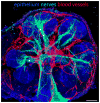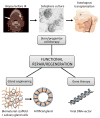Anatomy, biogenesis and regeneration of salivary glands
- PMID: 24862590
- PMCID: PMC4048853
- DOI: 10.1159/000358776
Anatomy, biogenesis and regeneration of salivary glands
Abstract
An overview of the anatomy and biogenesis of salivary glands is important in order to understand the physiology, functions and disorders associated with saliva. A major disorder of salivary glands is salivary hypofunction and resulting xerostomia, or dry mouth, which affects hundreds of thousands of patients each year who suffer from salivary gland diseases or undergo head and neck cancer treatment. There is currently no curative therapy for these patients. To improve these patients' quality of life, new therapies are being developed based on findings in salivary gland cell and developmental biology. Here we discuss the anatomy and biogenesis of the major human salivary glands and the rodent submandibular gland, which has been used extensively as a research model. We also include a review of recent research on the identification and function of stem cells in salivary glands, and the emerging field of research suggesting that nerves play an instructive role during development and may be essential for adult gland repair and regeneration. Understanding the molecular mechanisms involved in gland biogenesis provides a template for regenerating, repairing or reengineering diseased or damaged adult human salivary glands. We provide an overview of 3 general approaches currently being developed to regenerate damaged salivary tissue, including gene therapy, stem cell-based therapy and tissue engineering. In the future, it may be that a combination of all three will be used to repair, regenerate and reengineer functional salivary glands in patients to increase the secretion of their saliva, the focus of this monograph.
Figures




References
-
- Carlson GW. The salivary glands: Embryology, anatomy, and surgical applications. Surgical Clinics of North America. 2000;80:261–273. - PubMed
-
- Johns ME. Salivary-glands - anatomy and embryology. Otolaryngol Clin N Am. 1977;10:261–271. - PubMed
-
- Ten Cate AR. Oral histology : Development, structure, and function. 5. St. Louis: Mosby; 1998.
-
- Davis RA, Anson BJ, Budinger JM, Kurth LR. Surgical anatomy of the facial nerve and parotid gland based upon a study of 350 cervicofacial halves. Surgery, gynecology & obstetrics. 1956;102:385–412. - PubMed
Publication types
MeSH terms
Grants and funding
LinkOut - more resources
Full Text Sources
Other Literature Sources

